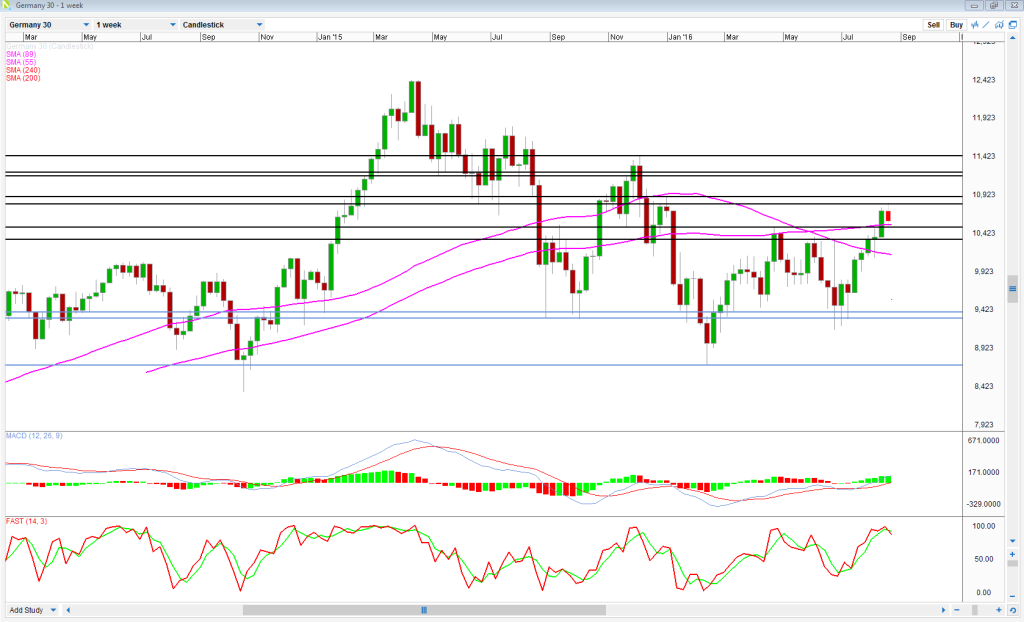What impact has Brexit had on Germany?
It’s still too early to determine what the economic impact of Brexit will be on Germany – and the eurozone on the whole for that matter – both in the near-term and beyond. On the one hand, the U.K. conducts a lot of trade with the E.U. with the latter actually being a net beneficiary of this. On the other hand, the remaining E.U. countries now have an opportunity to conduct more trade with each other and even chip away at U.K. industries – financial services being the most notable – something that would have caused significant friction had the U.K. voted to remain.
An early casualty of the vote was sentiment, with the ZEW economic sentiment – a survey of the 6-month economic outlook for 275 institutional investors and analysts – for July dropping to the lowest level since November 2012. Other sentiment readings haven’t fared so badly, with the manufacturing PMI, Ifo business climate and Gfk consumer surveys dipping slightly and the services PMI actually rising in July.
British Pound 6 Month Outlook 2016 2H
What can we expect going forward?
The outlook for the German economy hasn’t changed too much in the near-term. With the U.K. indicating that it doesn’t expect to trigger article 50 this year, the next six months could pass by with relatively little disruption. The initial hit to sentiment on the back of the Brexit vote was likely a knee jerk reaction and once the dust settles, assuming nothing else drastic happens, this may well pick up again.
Central banks have appeared eager to pre-empt any negative consequences of the vote by providing further monetary accommodation to cushion the blow, although at the time of writing only the Bank of Japan has actually acted and even this was not well received in the markets. Ultimately though, it will be down to the governments to support the economy with more expansionary fiscal policies if they do in fact view Brexit as a significant threat to the fragile economic recovery in the eurozone.
The benefit of further monetary stimulus from the ECB is that it could provide support for the equity markets in the meantime and help repair the damage done to sentiment by the Brexit vote. The flip side to this is that markets were not particularly impressed by the ECBs “bazooka” back in March so even if we got more stimulus, it doesn’t necessarily mean investors will approve.
Gold Forecast for Second Half of 2016 – Trends And Expectations
It’s also worth noting that Brexit isn’t the only risk to the Germany economy or stock market. The eurozone remains a ticking time bomb and while the risks may currently be among the lowest they’ve been for eight years, there is always something bubbling under the surface that could trigger the next crisis. The one that stands out currently is the issues in the banking sector, particularly in Italy where the size of the non-performing loans in certain banks has raised major concerns.
The other risk that stands out is China. Back in August, panic sparked by the depreciation of the yuan – but in reality caused by many underlying concerns with the economy – caused the DAX to plummet by almost 20% in just under two weeks. This happened again in January this year when the DAX again fell by almost 20%, this time in the space of six weeks. There is no reason why this couldn’t happen again and clearly, the DAX is very vulnerable to such moves. Potentially due to its tight trade connections with China.
What does this mean for the DAX?
At the time of writing, the DAX has finally in recent days moved back above the pre-Brexit levels, a move which would suggest the initial panic is relation to the vote is passing. That’s not to say that it won’t return, possibly once article 50 is triggered, but it certainly appears to have passed for now and it could remain that way for some months. It’s also worth noting that expectations for ECB stimulus have grown considerably since the referendum which is likely helping to support or even drive the rally.
AUD/USD Australian Dollar 6 Month Outlook 2016 2H
The DAX has currently broken through resistance around 10,350-10,500 which was quite bullish given the streak it was already on. Should investor sentiment remain buoyed in the coming months and the biggest risks not materialise – particularly those mentioned earlier in the article – we could see the index challenging the highs from the end of last year around 11,433.
It’s worth noting that substantial downside risks remain for the index and the higher it gets in the meantime, the higher these risks could become. Given that we’ve seen a close to 20% decline on the last two occasions that China has shaken global markets, we can’t write that off as being a possibility again. That said, it is again worth noting that we had a significant depreciation of the yuan over the last three months or so and investors were relatively unshaken by it. Perhaps the Brexit vote took the attention away from this or maybe as with everything in the markets, this has evolved and the next trigger will be different to the last two occasions. Either way, we must remain vigilant.

